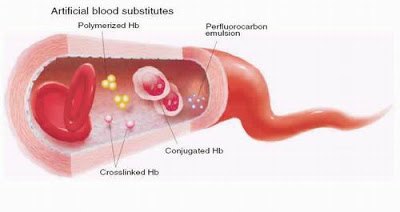One of the hottest medcal contests of the past three decades has been the race to develop a universal substitute for human blood that is safe, inexpensive, and disease free and that has a long shelf life.
Other researchers are pursuing chemical-based strategies that rely on perfluorocarbons (PFCs), which are artificial O2-carrying compounds composed of carbon and fluorine. PFCs are completely inert, chemically synthesized molecules that can dissolve large quantities of O2 in direct proportion to the amount of O2 breathed in. Because they are derived from a nonbiological source, PFCs cannot transmit disease. This, coupled with their low cost, makes them attractive as a blood substitute. Yet use of PFCs is not without risk. Their administration can cause flulike symptoms, and because of poor excretion, they may be retained and accumulate in the body. Ironically, PFC administration poses the danger of causing O2 toxicity by delivering too much O2 to the tissues in uncontrolled fashion.

A more recent strategy under development is a water-soluble, synthetic plastic version of hemoglobin. The molecule has the same size and shape of hemoglobin, reversibly binds with O2, and is made from a substance known to be safe in the body, but it has not yet undergone biological testing.